Project Plan and Questions on Project Management for City Towers
VerifiedAdded on 2020/04/13
|20
|3963
|109
Project
AI Summary
This project management assignment, submitted by a student, presents a comprehensive analysis of an IT and communication infrastructure project for City Towers hotel. The assignment begins with short-answer questions covering fundamental project management concepts, including project characteristics, scope statements, scheduling tools (Gantt charts and critical path method), budget development, risk responses, and quality planning. The core of the assignment is a case study report detailing the installation, testing, and commissioning of IT infrastructure. The report follows the project life cycle, starting with initiation, which includes a statement of work, project charter, and stakeholder identification. The planning phase encompasses cost management, quality management, procurement planning, and risk management, including a probability/impact matrix and risk register. The assignment provides detailed insights into the practical application of project management methodologies, techniques, and tools, making it a valuable resource for students studying project management.
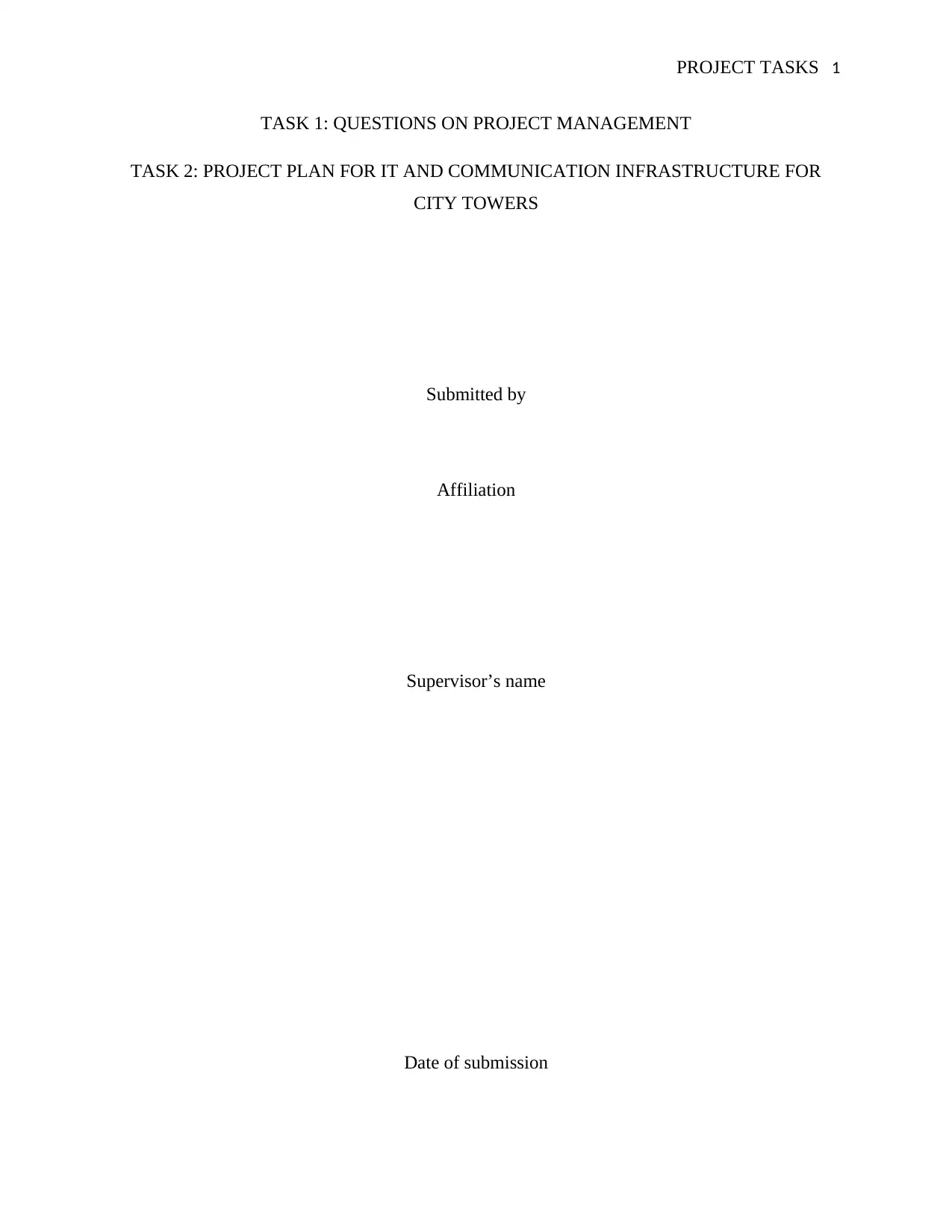
PROJECT TASKS 1
TASK 1: QUESTIONS ON PROJECT MANAGEMENT
TASK 2: PROJECT PLAN FOR IT AND COMMUNICATION INFRASTRUCTURE FOR
CITY TOWERS
Submitted by
Affiliation
Supervisor’s name
Date of submission
TASK 1: QUESTIONS ON PROJECT MANAGEMENT
TASK 2: PROJECT PLAN FOR IT AND COMMUNICATION INFRASTRUCTURE FOR
CITY TOWERS
Submitted by
Affiliation
Supervisor’s name
Date of submission
Paraphrase This Document
Need a fresh take? Get an instant paraphrase of this document with our AI Paraphraser
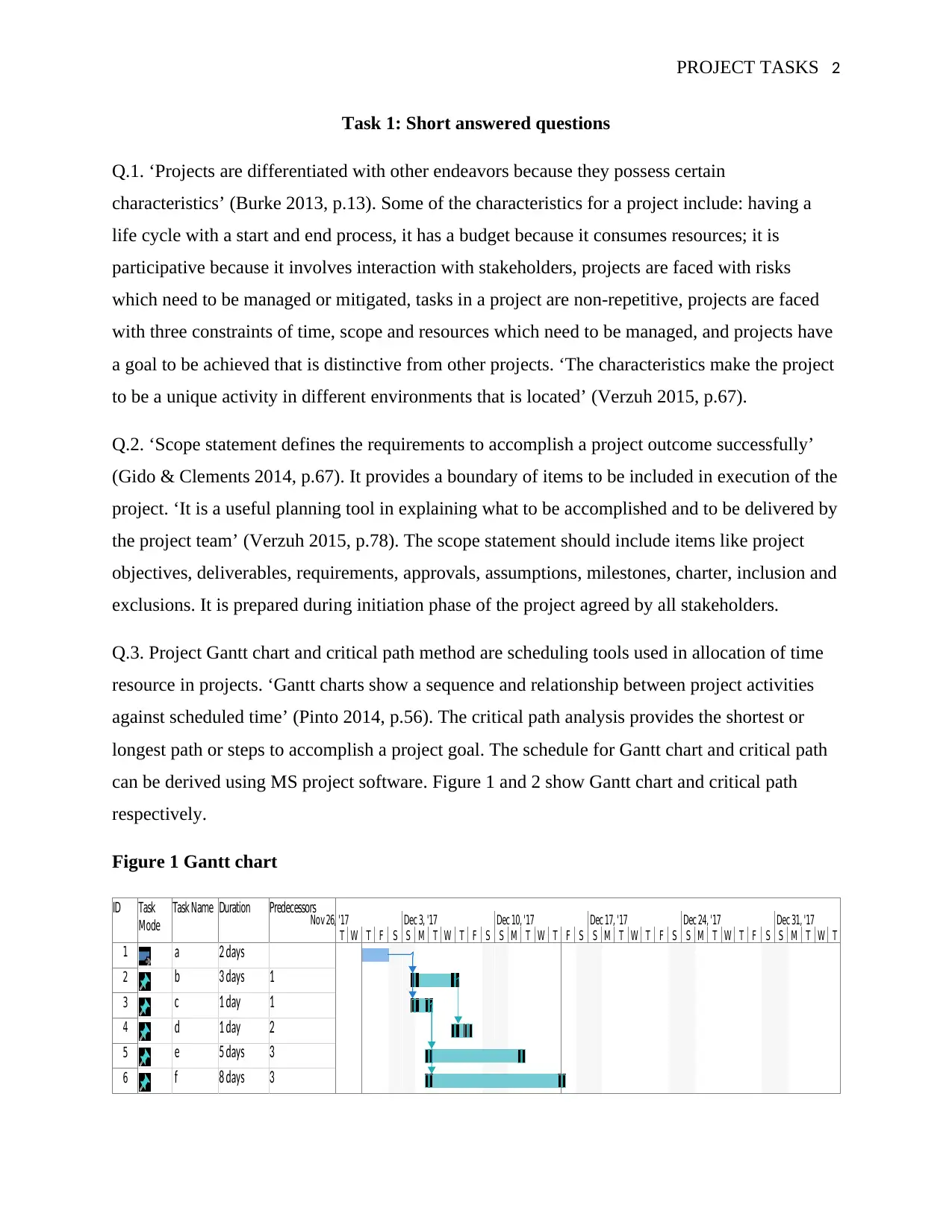
PROJECT TASKS 2
Task 1: Short answered questions
Q.1. ‘Projects are differentiated with other endeavors because they possess certain
characteristics’ (Burke 2013, p.13). Some of the characteristics for a project include: having a
life cycle with a start and end process, it has a budget because it consumes resources; it is
participative because it involves interaction with stakeholders, projects are faced with risks
which need to be managed or mitigated, tasks in a project are non-repetitive, projects are faced
with three constraints of time, scope and resources which need to be managed, and projects have
a goal to be achieved that is distinctive from other projects. ‘The characteristics make the project
to be a unique activity in different environments that is located’ (Verzuh 2015, p.67).
Q.2. ‘Scope statement defines the requirements to accomplish a project outcome successfully’
(Gido & Clements 2014, p.67). It provides a boundary of items to be included in execution of the
project. ‘It is a useful planning tool in explaining what to be accomplished and to be delivered by
the project team’ (Verzuh 2015, p.78). The scope statement should include items like project
objectives, deliverables, requirements, approvals, assumptions, milestones, charter, inclusion and
exclusions. It is prepared during initiation phase of the project agreed by all stakeholders.
Q.3. Project Gantt chart and critical path method are scheduling tools used in allocation of time
resource in projects. ‘Gantt charts show a sequence and relationship between project activities
against scheduled time’ (Pinto 2014, p.56). The critical path analysis provides the shortest or
longest path or steps to accomplish a project goal. The schedule for Gantt chart and critical path
can be derived using MS project software. Figure 1 and 2 show Gantt chart and critical path
respectively.
Figure 1 Gantt chart
ID Task
Mode
Task Name Duration Predecessors
1 a 2 days
2 b 3 days 1
3 c 1 day 1
4 d 1 day 2
5 e 5 days 3
6 f 8 days 3
T W T F S S M T W T F S S M T W T F S S M T W T F S S M T W T F S S M T W T
Nov 26, '17 Dec 3, '17 Dec 10, '17 Dec 17, '17 Dec 24, '17 Dec 31, '17
Task 1: Short answered questions
Q.1. ‘Projects are differentiated with other endeavors because they possess certain
characteristics’ (Burke 2013, p.13). Some of the characteristics for a project include: having a
life cycle with a start and end process, it has a budget because it consumes resources; it is
participative because it involves interaction with stakeholders, projects are faced with risks
which need to be managed or mitigated, tasks in a project are non-repetitive, projects are faced
with three constraints of time, scope and resources which need to be managed, and projects have
a goal to be achieved that is distinctive from other projects. ‘The characteristics make the project
to be a unique activity in different environments that is located’ (Verzuh 2015, p.67).
Q.2. ‘Scope statement defines the requirements to accomplish a project outcome successfully’
(Gido & Clements 2014, p.67). It provides a boundary of items to be included in execution of the
project. ‘It is a useful planning tool in explaining what to be accomplished and to be delivered by
the project team’ (Verzuh 2015, p.78). The scope statement should include items like project
objectives, deliverables, requirements, approvals, assumptions, milestones, charter, inclusion and
exclusions. It is prepared during initiation phase of the project agreed by all stakeholders.
Q.3. Project Gantt chart and critical path method are scheduling tools used in allocation of time
resource in projects. ‘Gantt charts show a sequence and relationship between project activities
against scheduled time’ (Pinto 2014, p.56). The critical path analysis provides the shortest or
longest path or steps to accomplish a project goal. The schedule for Gantt chart and critical path
can be derived using MS project software. Figure 1 and 2 show Gantt chart and critical path
respectively.
Figure 1 Gantt chart
ID Task
Mode
Task Name Duration Predecessors
1 a 2 days
2 b 3 days 1
3 c 1 day 1
4 d 1 day 2
5 e 5 days 3
6 f 8 days 3
T W T F S S M T W T F S S M T W T F S S M T W T F S S M T W T F S S M T W T
Nov 26, '17 Dec 3, '17 Dec 10, '17 Dec 17, '17 Dec 24, '17 Dec 31, '17

PROJECT TASKS 3
Figure 2 Critical path
b
Sta rt: Mon 12/4/17 ID: 2
Fi ni sh: Wed 12/6/17 Dur: 3 days
Res:
c
Sta rt: Mon 12/4/17 ID: 3
Fi ni sh: Mon 12/4/17 Dur: 1 day
Res:
d
Start: Thu 12/7/17 ID: 4
Fi ni sh: Thu 12/7/17 Dur: 1 day
Res:
e
Start: Tue 12/5/17 ID: 5
Fi ni sh: Mon 12/11/17Dur: 5 days
Res:
f
Start: Tue 12/5/17 ID: 6
Fi ni sh: Thu 12/14/17Dur: 8 days
Res:
a
Sta rt: Thu 11/30/17 ID: 1
Finish: Fri 12/1/17 Dur: 2 da ys
Res:
The critical path is indicated using the red color. The critical path computation follows task (a) to
(c) to (f) = 2days + 3days +6days = 10 days. The critical path is 10 days for the computation.
Q.4. There is several factors that need to be considered when developing a budget for a project.
‘The first item to be considered is the approach that will be followed in estimating requirements
for example parametric, bottom-up and top bottom approaches’ (Zulch 2014, p.56). The
approach chosen will guide the type of project to be formulated. The other critical factors to be
considered are availability of resources, costs of estimates, tools for budgeting process, and
baseline information of the project. The baseline information provides for the scope and nature
of the project (Zulch 2014, p.56). Tools for budgeting process represent technical or operative
inputs that can aid budget development.
Q.5. Project management teams after identifying, assessing risks they need to formulate ways to
manage the risk known as risk responses. Risk responses include activities performed by project
teams that could enhance opportunities and reduce threats to project delivery. ‘Risk responses are
part of the phases of risk management process, (Kloppenborg 2014, p.34). Examples of risks
responses that can be used in projects include: transferring by sharing risk consequences with a
Figure 2 Critical path
b
Sta rt: Mon 12/4/17 ID: 2
Fi ni sh: Wed 12/6/17 Dur: 3 days
Res:
c
Sta rt: Mon 12/4/17 ID: 3
Fi ni sh: Mon 12/4/17 Dur: 1 day
Res:
d
Start: Thu 12/7/17 ID: 4
Fi ni sh: Thu 12/7/17 Dur: 1 day
Res:
e
Start: Tue 12/5/17 ID: 5
Fi ni sh: Mon 12/11/17Dur: 5 days
Res:
f
Start: Tue 12/5/17 ID: 6
Fi ni sh: Thu 12/14/17Dur: 8 days
Res:
a
Sta rt: Thu 11/30/17 ID: 1
Finish: Fri 12/1/17 Dur: 2 da ys
Res:
The critical path is indicated using the red color. The critical path computation follows task (a) to
(c) to (f) = 2days + 3days +6days = 10 days. The critical path is 10 days for the computation.
Q.4. There is several factors that need to be considered when developing a budget for a project.
‘The first item to be considered is the approach that will be followed in estimating requirements
for example parametric, bottom-up and top bottom approaches’ (Zulch 2014, p.56). The
approach chosen will guide the type of project to be formulated. The other critical factors to be
considered are availability of resources, costs of estimates, tools for budgeting process, and
baseline information of the project. The baseline information provides for the scope and nature
of the project (Zulch 2014, p.56). Tools for budgeting process represent technical or operative
inputs that can aid budget development.
Q.5. Project management teams after identifying, assessing risks they need to formulate ways to
manage the risk known as risk responses. Risk responses include activities performed by project
teams that could enhance opportunities and reduce threats to project delivery. ‘Risk responses are
part of the phases of risk management process, (Kloppenborg 2014, p.34). Examples of risks
responses that can be used in projects include: transferring by sharing risk consequences with a
⊘ This is a preview!⊘
Do you want full access?
Subscribe today to unlock all pages.

Trusted by 1+ million students worldwide
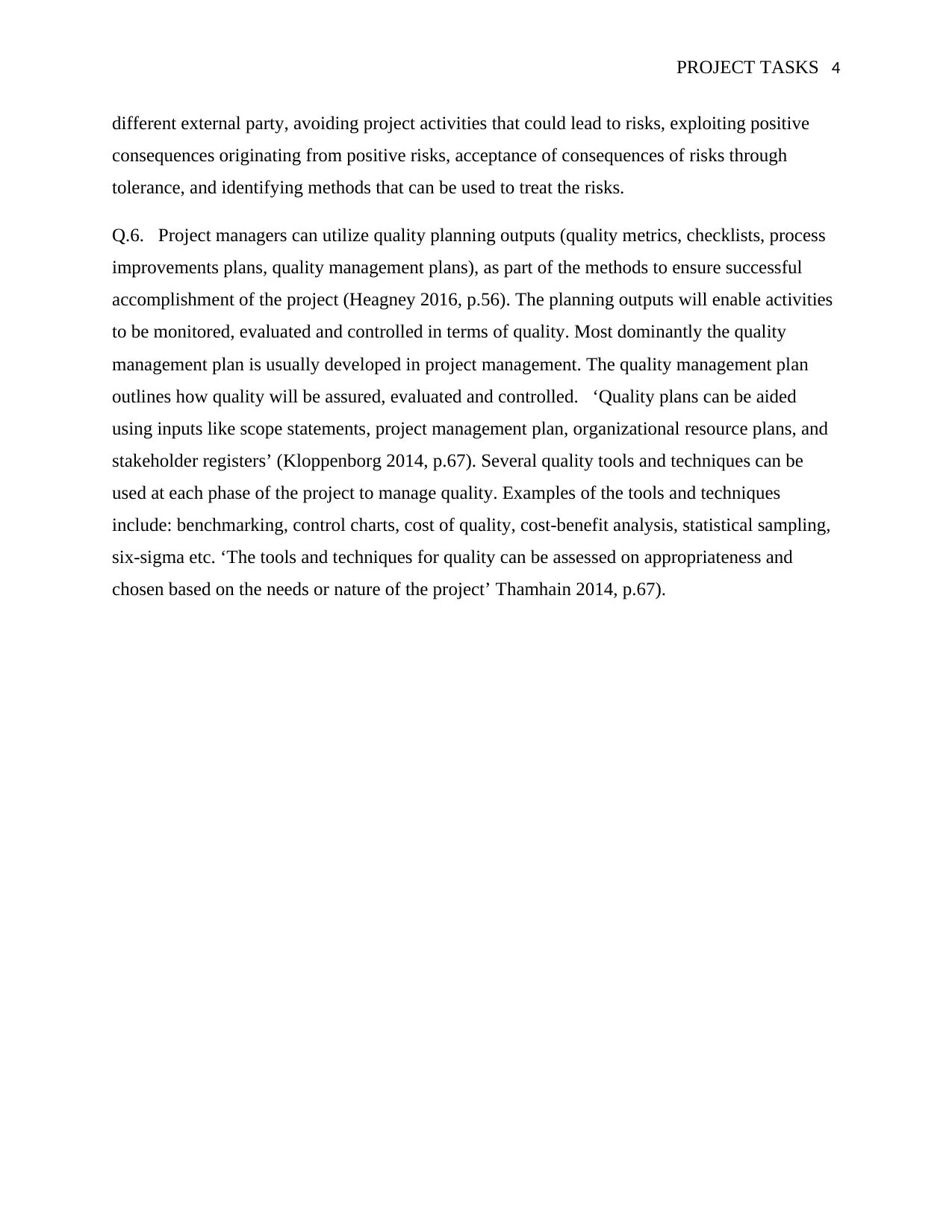
PROJECT TASKS 4
different external party, avoiding project activities that could lead to risks, exploiting positive
consequences originating from positive risks, acceptance of consequences of risks through
tolerance, and identifying methods that can be used to treat the risks.
Q.6. Project managers can utilize quality planning outputs (quality metrics, checklists, process
improvements plans, quality management plans), as part of the methods to ensure successful
accomplishment of the project (Heagney 2016, p.56). The planning outputs will enable activities
to be monitored, evaluated and controlled in terms of quality. Most dominantly the quality
management plan is usually developed in project management. The quality management plan
outlines how quality will be assured, evaluated and controlled. ‘Quality plans can be aided
using inputs like scope statements, project management plan, organizational resource plans, and
stakeholder registers’ (Kloppenborg 2014, p.67). Several quality tools and techniques can be
used at each phase of the project to manage quality. Examples of the tools and techniques
include: benchmarking, control charts, cost of quality, cost-benefit analysis, statistical sampling,
six-sigma etc. ‘The tools and techniques for quality can be assessed on appropriateness and
chosen based on the needs or nature of the project’ Thamhain 2014, p.67).
different external party, avoiding project activities that could lead to risks, exploiting positive
consequences originating from positive risks, acceptance of consequences of risks through
tolerance, and identifying methods that can be used to treat the risks.
Q.6. Project managers can utilize quality planning outputs (quality metrics, checklists, process
improvements plans, quality management plans), as part of the methods to ensure successful
accomplishment of the project (Heagney 2016, p.56). The planning outputs will enable activities
to be monitored, evaluated and controlled in terms of quality. Most dominantly the quality
management plan is usually developed in project management. The quality management plan
outlines how quality will be assured, evaluated and controlled. ‘Quality plans can be aided
using inputs like scope statements, project management plan, organizational resource plans, and
stakeholder registers’ (Kloppenborg 2014, p.67). Several quality tools and techniques can be
used at each phase of the project to manage quality. Examples of the tools and techniques
include: benchmarking, control charts, cost of quality, cost-benefit analysis, statistical sampling,
six-sigma etc. ‘The tools and techniques for quality can be assessed on appropriateness and
chosen based on the needs or nature of the project’ Thamhain 2014, p.67).
Paraphrase This Document
Need a fresh take? Get an instant paraphrase of this document with our AI Paraphraser
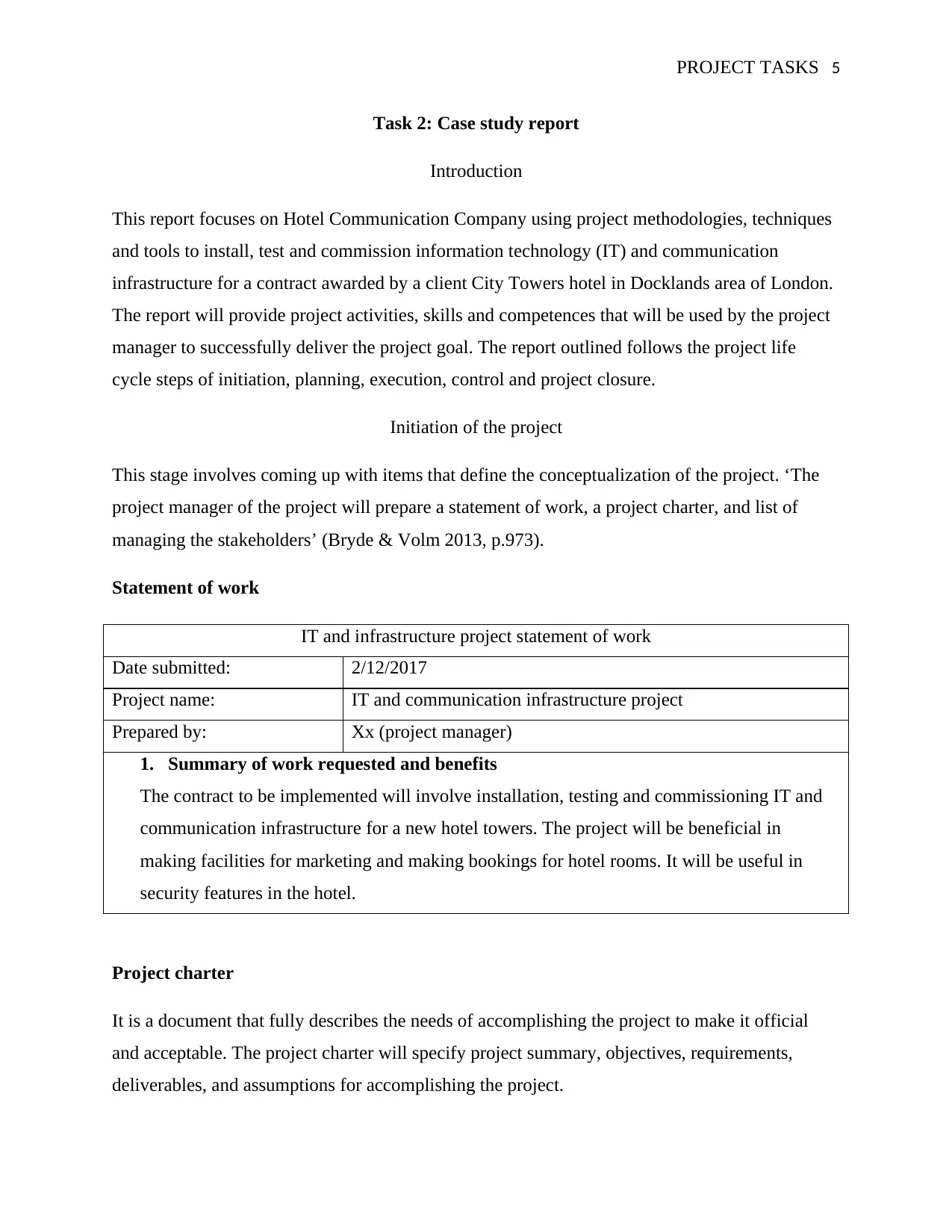
PROJECT TASKS 5
Task 2: Case study report
Introduction
This report focuses on Hotel Communication Company using project methodologies, techniques
and tools to install, test and commission information technology (IT) and communication
infrastructure for a contract awarded by a client City Towers hotel in Docklands area of London.
The report will provide project activities, skills and competences that will be used by the project
manager to successfully deliver the project goal. The report outlined follows the project life
cycle steps of initiation, planning, execution, control and project closure.
Initiation of the project
This stage involves coming up with items that define the conceptualization of the project. ‘The
project manager of the project will prepare a statement of work, a project charter, and list of
managing the stakeholders’ (Bryde & Volm 2013, p.973).
Statement of work
IT and infrastructure project statement of work
Date submitted: 2/12/2017
Project name: IT and communication infrastructure project
Prepared by: Xx (project manager)
1. Summary of work requested and benefits
The contract to be implemented will involve installation, testing and commissioning IT and
communication infrastructure for a new hotel towers. The project will be beneficial in
making facilities for marketing and making bookings for hotel rooms. It will be useful in
security features in the hotel.
Project charter
It is a document that fully describes the needs of accomplishing the project to make it official
and acceptable. The project charter will specify project summary, objectives, requirements,
deliverables, and assumptions for accomplishing the project.
Task 2: Case study report
Introduction
This report focuses on Hotel Communication Company using project methodologies, techniques
and tools to install, test and commission information technology (IT) and communication
infrastructure for a contract awarded by a client City Towers hotel in Docklands area of London.
The report will provide project activities, skills and competences that will be used by the project
manager to successfully deliver the project goal. The report outlined follows the project life
cycle steps of initiation, planning, execution, control and project closure.
Initiation of the project
This stage involves coming up with items that define the conceptualization of the project. ‘The
project manager of the project will prepare a statement of work, a project charter, and list of
managing the stakeholders’ (Bryde & Volm 2013, p.973).
Statement of work
IT and infrastructure project statement of work
Date submitted: 2/12/2017
Project name: IT and communication infrastructure project
Prepared by: Xx (project manager)
1. Summary of work requested and benefits
The contract to be implemented will involve installation, testing and commissioning IT and
communication infrastructure for a new hotel towers. The project will be beneficial in
making facilities for marketing and making bookings for hotel rooms. It will be useful in
security features in the hotel.
Project charter
It is a document that fully describes the needs of accomplishing the project to make it official
and acceptable. The project charter will specify project summary, objectives, requirements,
deliverables, and assumptions for accomplishing the project.
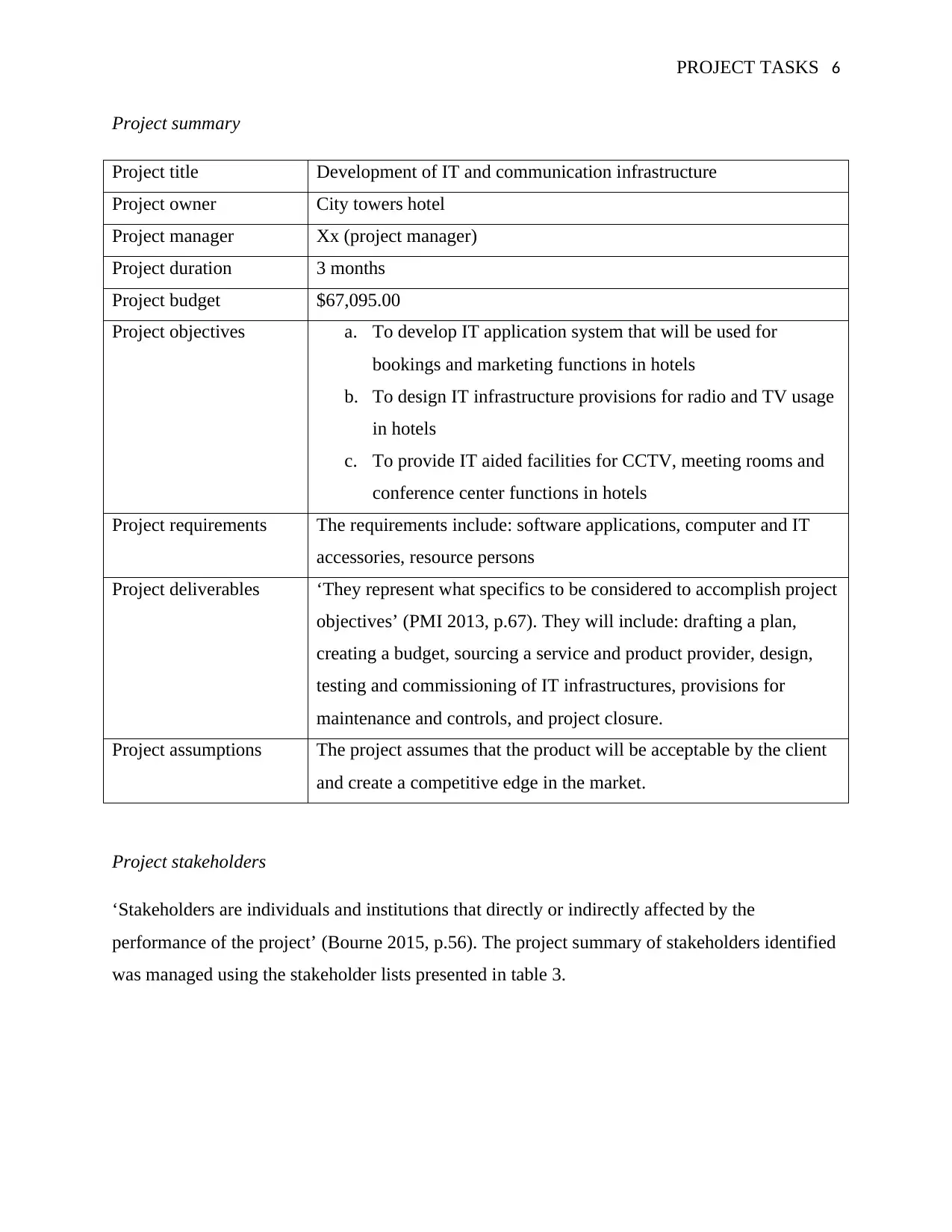
PROJECT TASKS 6
Project summary
Project title Development of IT and communication infrastructure
Project owner City towers hotel
Project manager Xx (project manager)
Project duration 3 months
Project budget $67,095.00
Project objectives a. To develop IT application system that will be used for
bookings and marketing functions in hotels
b. To design IT infrastructure provisions for radio and TV usage
in hotels
c. To provide IT aided facilities for CCTV, meeting rooms and
conference center functions in hotels
Project requirements The requirements include: software applications, computer and IT
accessories, resource persons
Project deliverables ‘They represent what specifics to be considered to accomplish project
objectives’ (PMI 2013, p.67). They will include: drafting a plan,
creating a budget, sourcing a service and product provider, design,
testing and commissioning of IT infrastructures, provisions for
maintenance and controls, and project closure.
Project assumptions The project assumes that the product will be acceptable by the client
and create a competitive edge in the market.
Project stakeholders
‘Stakeholders are individuals and institutions that directly or indirectly affected by the
performance of the project’ (Bourne 2015, p.56). The project summary of stakeholders identified
was managed using the stakeholder lists presented in table 3.
Project summary
Project title Development of IT and communication infrastructure
Project owner City towers hotel
Project manager Xx (project manager)
Project duration 3 months
Project budget $67,095.00
Project objectives a. To develop IT application system that will be used for
bookings and marketing functions in hotels
b. To design IT infrastructure provisions for radio and TV usage
in hotels
c. To provide IT aided facilities for CCTV, meeting rooms and
conference center functions in hotels
Project requirements The requirements include: software applications, computer and IT
accessories, resource persons
Project deliverables ‘They represent what specifics to be considered to accomplish project
objectives’ (PMI 2013, p.67). They will include: drafting a plan,
creating a budget, sourcing a service and product provider, design,
testing and commissioning of IT infrastructures, provisions for
maintenance and controls, and project closure.
Project assumptions The project assumes that the product will be acceptable by the client
and create a competitive edge in the market.
Project stakeholders
‘Stakeholders are individuals and institutions that directly or indirectly affected by the
performance of the project’ (Bourne 2015, p.56). The project summary of stakeholders identified
was managed using the stakeholder lists presented in table 3.
⊘ This is a preview!⊘
Do you want full access?
Subscribe today to unlock all pages.

Trusted by 1+ million students worldwide
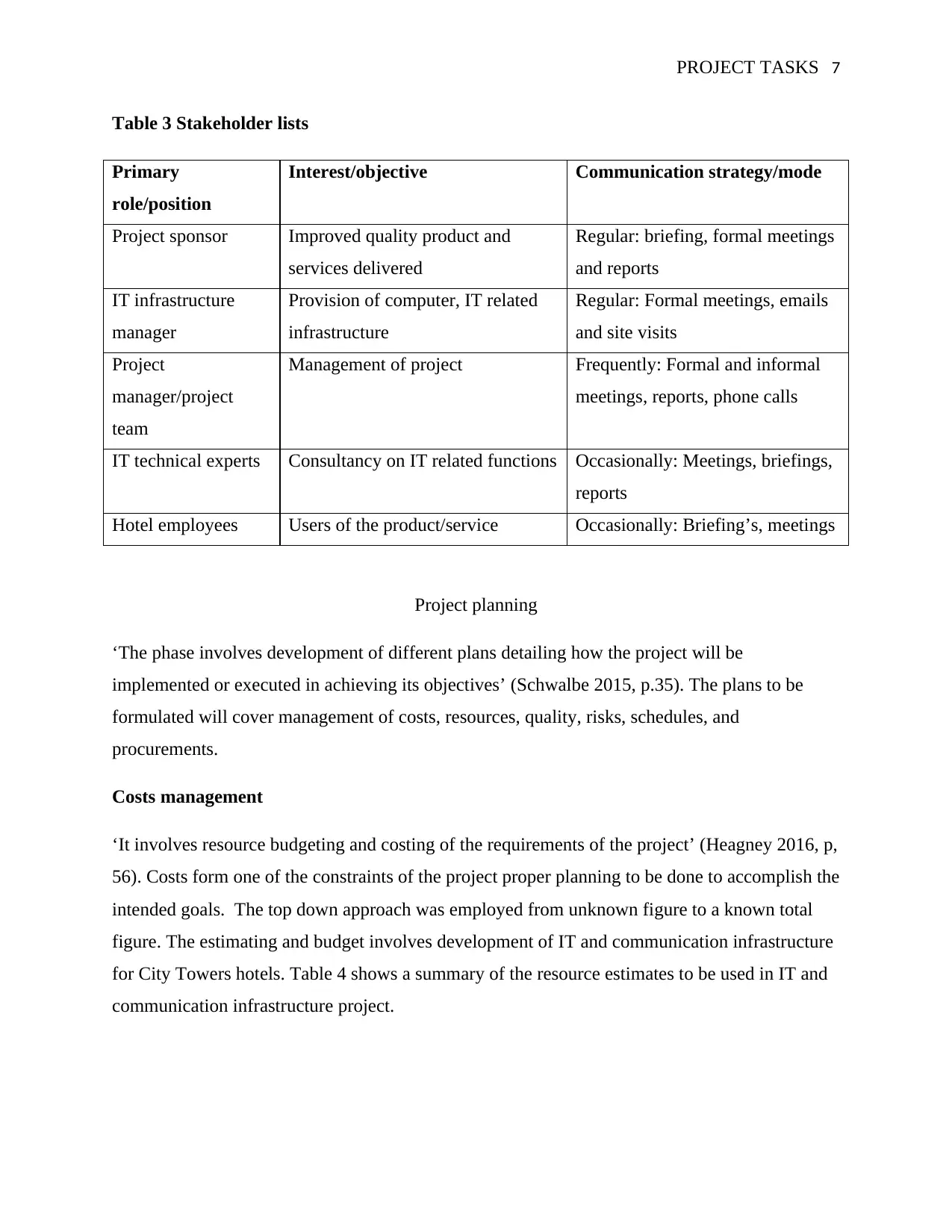
PROJECT TASKS 7
Table 3 Stakeholder lists
Primary
role/position
Interest/objective Communication strategy/mode
Project sponsor Improved quality product and
services delivered
Regular: briefing, formal meetings
and reports
IT infrastructure
manager
Provision of computer, IT related
infrastructure
Regular: Formal meetings, emails
and site visits
Project
manager/project
team
Management of project Frequently: Formal and informal
meetings, reports, phone calls
IT technical experts Consultancy on IT related functions Occasionally: Meetings, briefings,
reports
Hotel employees Users of the product/service Occasionally: Briefing’s, meetings
Project planning
‘The phase involves development of different plans detailing how the project will be
implemented or executed in achieving its objectives’ (Schwalbe 2015, p.35). The plans to be
formulated will cover management of costs, resources, quality, risks, schedules, and
procurements.
Costs management
‘It involves resource budgeting and costing of the requirements of the project’ (Heagney 2016, p,
56). Costs form one of the constraints of the project proper planning to be done to accomplish the
intended goals. The top down approach was employed from unknown figure to a known total
figure. The estimating and budget involves development of IT and communication infrastructure
for City Towers hotels. Table 4 shows a summary of the resource estimates to be used in IT and
communication infrastructure project.
Table 3 Stakeholder lists
Primary
role/position
Interest/objective Communication strategy/mode
Project sponsor Improved quality product and
services delivered
Regular: briefing, formal meetings
and reports
IT infrastructure
manager
Provision of computer, IT related
infrastructure
Regular: Formal meetings, emails
and site visits
Project
manager/project
team
Management of project Frequently: Formal and informal
meetings, reports, phone calls
IT technical experts Consultancy on IT related functions Occasionally: Meetings, briefings,
reports
Hotel employees Users of the product/service Occasionally: Briefing’s, meetings
Project planning
‘The phase involves development of different plans detailing how the project will be
implemented or executed in achieving its objectives’ (Schwalbe 2015, p.35). The plans to be
formulated will cover management of costs, resources, quality, risks, schedules, and
procurements.
Costs management
‘It involves resource budgeting and costing of the requirements of the project’ (Heagney 2016, p,
56). Costs form one of the constraints of the project proper planning to be done to accomplish the
intended goals. The top down approach was employed from unknown figure to a known total
figure. The estimating and budget involves development of IT and communication infrastructure
for City Towers hotels. Table 4 shows a summary of the resource estimates to be used in IT and
communication infrastructure project.
Paraphrase This Document
Need a fresh take? Get an instant paraphrase of this document with our AI Paraphraser
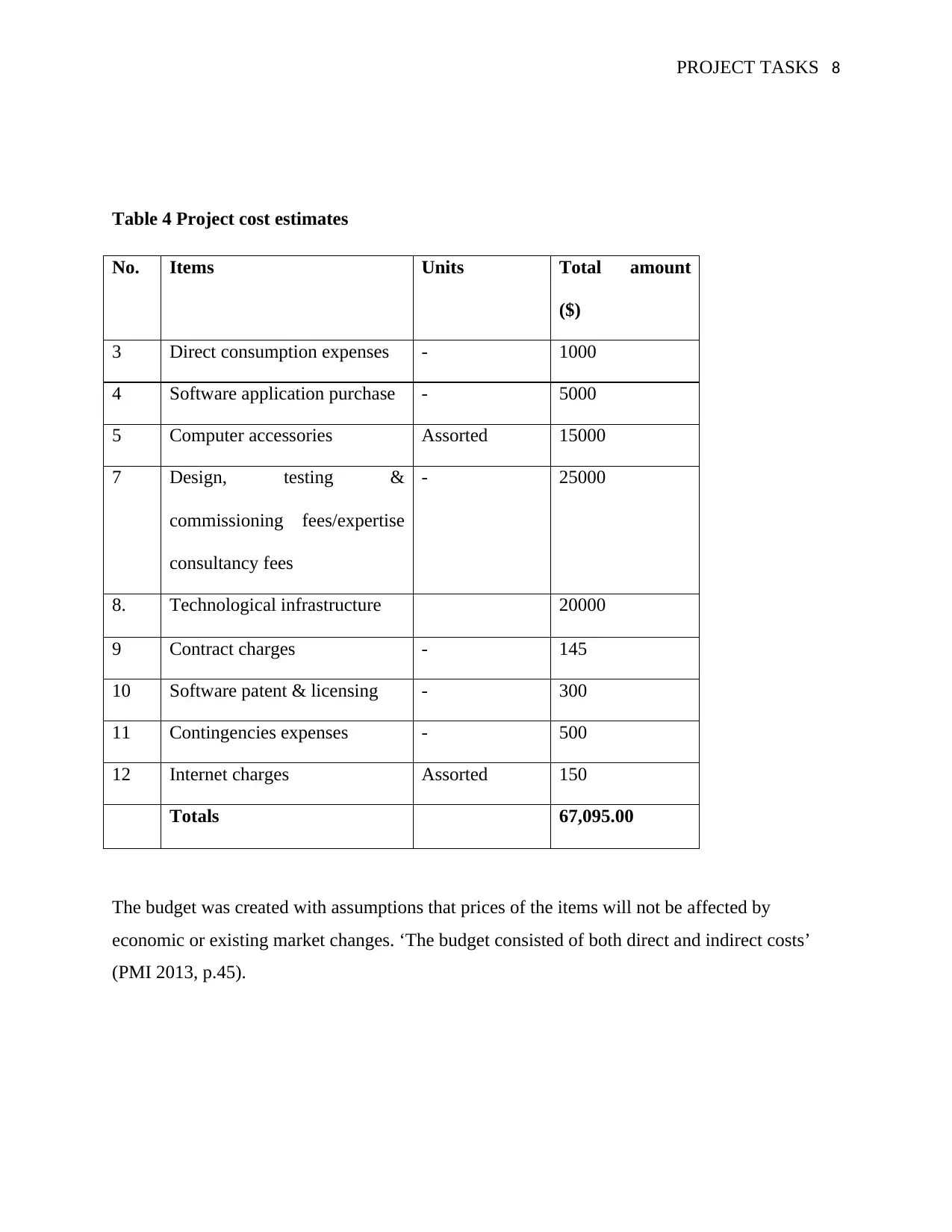
PROJECT TASKS 8
Table 4 Project cost estimates
No. Items Units Total amount
($)
3 Direct consumption expenses - 1000
4 Software application purchase - 5000
5 Computer accessories Assorted 15000
7 Design, testing &
commissioning fees/expertise
consultancy fees
- 25000
8. Technological infrastructure 20000
9 Contract charges - 145
10 Software patent & licensing - 300
11 Contingencies expenses - 500
12 Internet charges Assorted 150
Totals 67,095.00
The budget was created with assumptions that prices of the items will not be affected by
economic or existing market changes. ‘The budget consisted of both direct and indirect costs’
(PMI 2013, p.45).
Table 4 Project cost estimates
No. Items Units Total amount
($)
3 Direct consumption expenses - 1000
4 Software application purchase - 5000
5 Computer accessories Assorted 15000
7 Design, testing &
commissioning fees/expertise
consultancy fees
- 25000
8. Technological infrastructure 20000
9 Contract charges - 145
10 Software patent & licensing - 300
11 Contingencies expenses - 500
12 Internet charges Assorted 150
Totals 67,095.00
The budget was created with assumptions that prices of the items will not be affected by
economic or existing market changes. ‘The budget consisted of both direct and indirect costs’
(PMI 2013, p.45).

PROJECT TASKS 9
Quality management plan
Quality is an important component when ensuring that the products will be accepted and
approved by the final user. ‘The project will ensure that quality is planned, assured and
controlled’ (Gido & Clements 2014, p.86). Quality planning will involve use of quality lists and
checklists to ensure standards and specifications are followed.
Quality deliverables: ‘the following are quality deliverables that the project will tend to achieved
during the project delivery’ (Pritchard 2013, p.4). The software applications are designed to meet
current and future needs of the hotel, materials and infrastructures to be bought according to
required specifications, a right service provider and consultants chosen in an open and
accountable process. Project assurance: to ensure that the planned quality measures are
maintained consistently the project team will follow the project processes and activities based on
professional checklists. Table 5 presents a summary of quality checklists that will be followed to
ensure quality is maintained and achieved during the project life cycle.
Table 5 Quality checklists
Activities and functions Status Comments
Done Not done
Good sourcing of service
providers done well
IT and Computer infrastructures
bought as per specifications
Software applications and
programs reflect current and
future needs
Maintenance and repair cautions
are in place
Provisions for monitoring and
audits are in place
A process of escalation is in place
Quality management plan
Quality is an important component when ensuring that the products will be accepted and
approved by the final user. ‘The project will ensure that quality is planned, assured and
controlled’ (Gido & Clements 2014, p.86). Quality planning will involve use of quality lists and
checklists to ensure standards and specifications are followed.
Quality deliverables: ‘the following are quality deliverables that the project will tend to achieved
during the project delivery’ (Pritchard 2013, p.4). The software applications are designed to meet
current and future needs of the hotel, materials and infrastructures to be bought according to
required specifications, a right service provider and consultants chosen in an open and
accountable process. Project assurance: to ensure that the planned quality measures are
maintained consistently the project team will follow the project processes and activities based on
professional checklists. Table 5 presents a summary of quality checklists that will be followed to
ensure quality is maintained and achieved during the project life cycle.
Table 5 Quality checklists
Activities and functions Status Comments
Done Not done
Good sourcing of service
providers done well
IT and Computer infrastructures
bought as per specifications
Software applications and
programs reflect current and
future needs
Maintenance and repair cautions
are in place
Provisions for monitoring and
audits are in place
A process of escalation is in place
⊘ This is a preview!⊘
Do you want full access?
Subscribe today to unlock all pages.

Trusted by 1+ million students worldwide
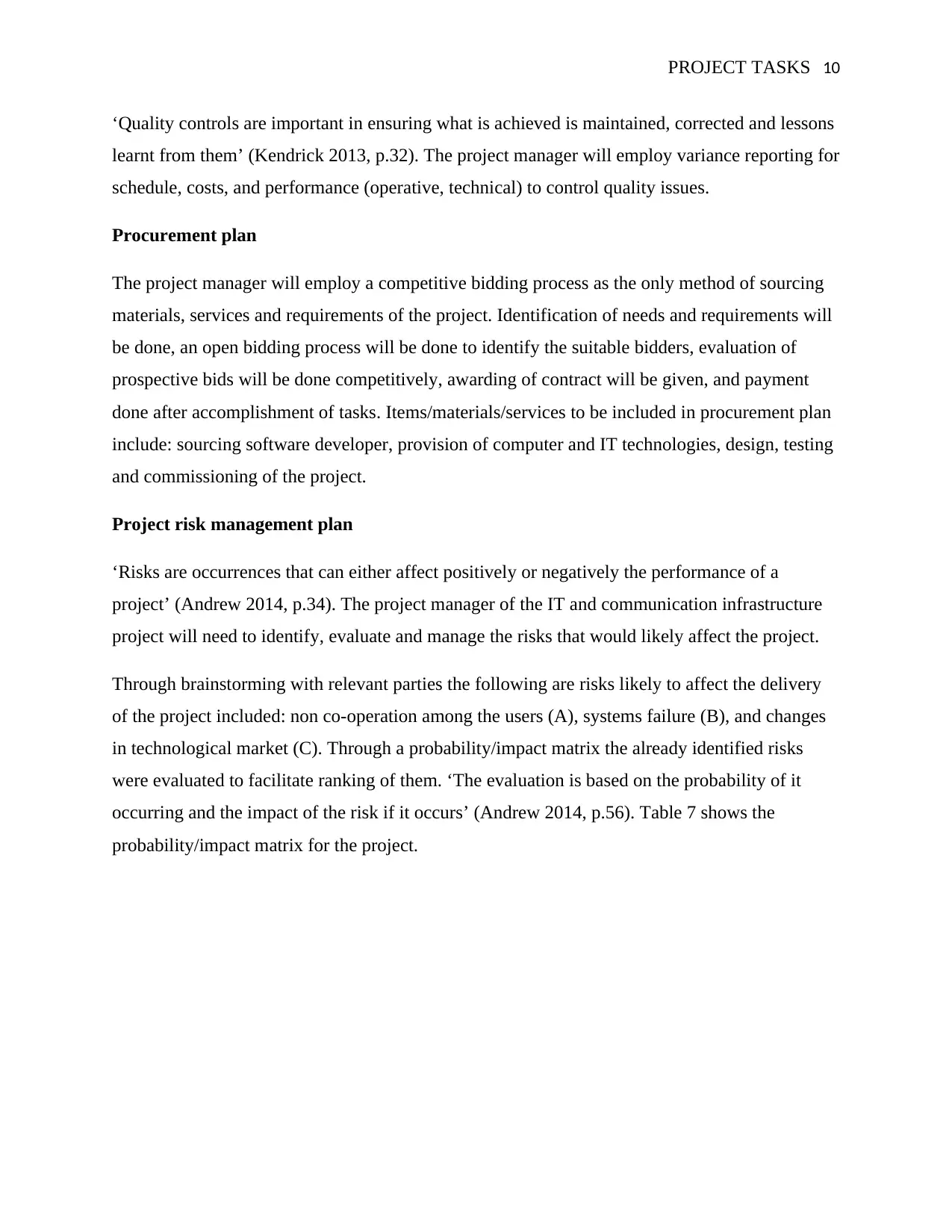
PROJECT TASKS 10
‘Quality controls are important in ensuring what is achieved is maintained, corrected and lessons
learnt from them’ (Kendrick 2013, p.32). The project manager will employ variance reporting for
schedule, costs, and performance (operative, technical) to control quality issues.
Procurement plan
The project manager will employ a competitive bidding process as the only method of sourcing
materials, services and requirements of the project. Identification of needs and requirements will
be done, an open bidding process will be done to identify the suitable bidders, evaluation of
prospective bids will be done competitively, awarding of contract will be given, and payment
done after accomplishment of tasks. Items/materials/services to be included in procurement plan
include: sourcing software developer, provision of computer and IT technologies, design, testing
and commissioning of the project.
Project risk management plan
‘Risks are occurrences that can either affect positively or negatively the performance of a
project’ (Andrew 2014, p.34). The project manager of the IT and communication infrastructure
project will need to identify, evaluate and manage the risks that would likely affect the project.
Through brainstorming with relevant parties the following are risks likely to affect the delivery
of the project included: non co-operation among the users (A), systems failure (B), and changes
in technological market (C). Through a probability/impact matrix the already identified risks
were evaluated to facilitate ranking of them. ‘The evaluation is based on the probability of it
occurring and the impact of the risk if it occurs’ (Andrew 2014, p.56). Table 7 shows the
probability/impact matrix for the project.
‘Quality controls are important in ensuring what is achieved is maintained, corrected and lessons
learnt from them’ (Kendrick 2013, p.32). The project manager will employ variance reporting for
schedule, costs, and performance (operative, technical) to control quality issues.
Procurement plan
The project manager will employ a competitive bidding process as the only method of sourcing
materials, services and requirements of the project. Identification of needs and requirements will
be done, an open bidding process will be done to identify the suitable bidders, evaluation of
prospective bids will be done competitively, awarding of contract will be given, and payment
done after accomplishment of tasks. Items/materials/services to be included in procurement plan
include: sourcing software developer, provision of computer and IT technologies, design, testing
and commissioning of the project.
Project risk management plan
‘Risks are occurrences that can either affect positively or negatively the performance of a
project’ (Andrew 2014, p.34). The project manager of the IT and communication infrastructure
project will need to identify, evaluate and manage the risks that would likely affect the project.
Through brainstorming with relevant parties the following are risks likely to affect the delivery
of the project included: non co-operation among the users (A), systems failure (B), and changes
in technological market (C). Through a probability/impact matrix the already identified risks
were evaluated to facilitate ranking of them. ‘The evaluation is based on the probability of it
occurring and the impact of the risk if it occurs’ (Andrew 2014, p.56). Table 7 shows the
probability/impact matrix for the project.
Paraphrase This Document
Need a fresh take? Get an instant paraphrase of this document with our AI Paraphraser
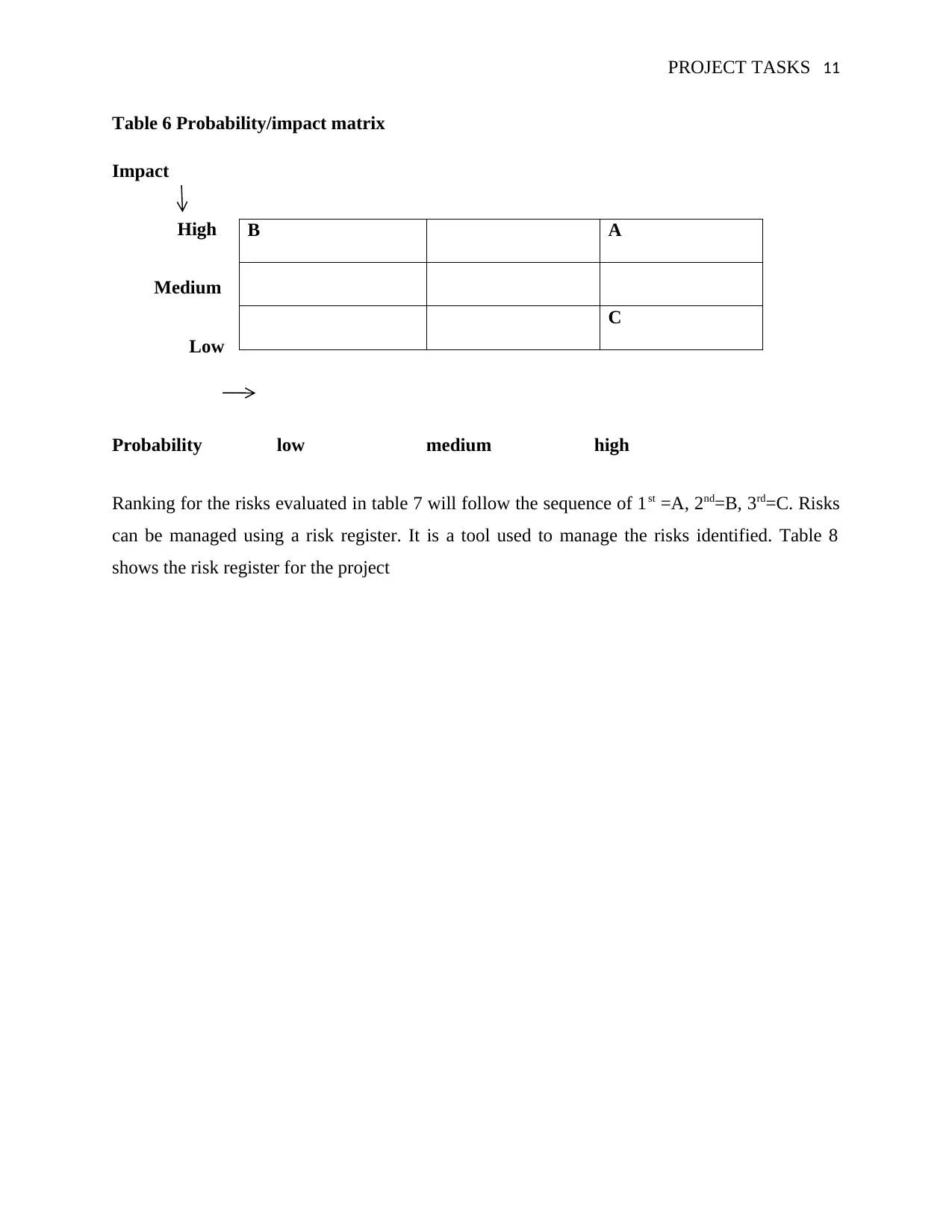
PROJECT TASKS 11
Table 6 Probability/impact matrix
Impact
High
Medium
Low
Probability low medium high
Ranking for the risks evaluated in table 7 will follow the sequence of 1st =A, 2nd=B, 3rd=C. Risks
can be managed using a risk register. It is a tool used to manage the risks identified. Table 8
shows the risk register for the project
B A
C
Table 6 Probability/impact matrix
Impact
High
Medium
Low
Probability low medium high
Ranking for the risks evaluated in table 7 will follow the sequence of 1st =A, 2nd=B, 3rd=C. Risks
can be managed using a risk register. It is a tool used to manage the risks identified. Table 8
shows the risk register for the project
B A
C

PROJECT TASKS 12
Table 7 Risk register for IT and computer infrastructure project
Rank Risk Description Root Cause Potential Responses Risk Owner Probability Impact
1 Non co-
operation
among users
The users may resist
in work structures
due to new changes
It may result if they
are not involved
Trainings and
involvement in
project activities
Project manager
and sponsor
High High
2 Technological
changes in the
market
New technological
implementation may
be affected by
changes in the
market of new
technologies
It results when a
non-researched
item is
implemented
The team will
ensure that items
that can be
upgraded are used
to caution any
changes
IT infrastructure
manager
high low
3 Systems
application &
program
failure
The systems or
program installed
may fail to perform
as required
It results when the
software app or
program was not
designed or tested
well.
Proper design and
testing need to be
done before any
commissioning
It infrastructure
manager and
project manager
Low High
Prepared by…………………………………………………………. Date prepared………………………………..
Approved by…………………………………………………………Date approved……………………………….
Dates for reviews 1st …………………………….2nd ……………………………..3rd…………………………….
Table 7 Risk register for IT and computer infrastructure project
Rank Risk Description Root Cause Potential Responses Risk Owner Probability Impact
1 Non co-
operation
among users
The users may resist
in work structures
due to new changes
It may result if they
are not involved
Trainings and
involvement in
project activities
Project manager
and sponsor
High High
2 Technological
changes in the
market
New technological
implementation may
be affected by
changes in the
market of new
technologies
It results when a
non-researched
item is
implemented
The team will
ensure that items
that can be
upgraded are used
to caution any
changes
IT infrastructure
manager
high low
3 Systems
application &
program
failure
The systems or
program installed
may fail to perform
as required
It results when the
software app or
program was not
designed or tested
well.
Proper design and
testing need to be
done before any
commissioning
It infrastructure
manager and
project manager
Low High
Prepared by…………………………………………………………. Date prepared………………………………..
Approved by…………………………………………………………Date approved……………………………….
Dates for reviews 1st …………………………….2nd ……………………………..3rd…………………………….
⊘ This is a preview!⊘
Do you want full access?
Subscribe today to unlock all pages.

Trusted by 1+ million students worldwide
1 out of 20
Related Documents
Your All-in-One AI-Powered Toolkit for Academic Success.
+13062052269
info@desklib.com
Available 24*7 on WhatsApp / Email
![[object Object]](/_next/static/media/star-bottom.7253800d.svg)
Unlock your academic potential
Copyright © 2020–2025 A2Z Services. All Rights Reserved. Developed and managed by ZUCOL.





